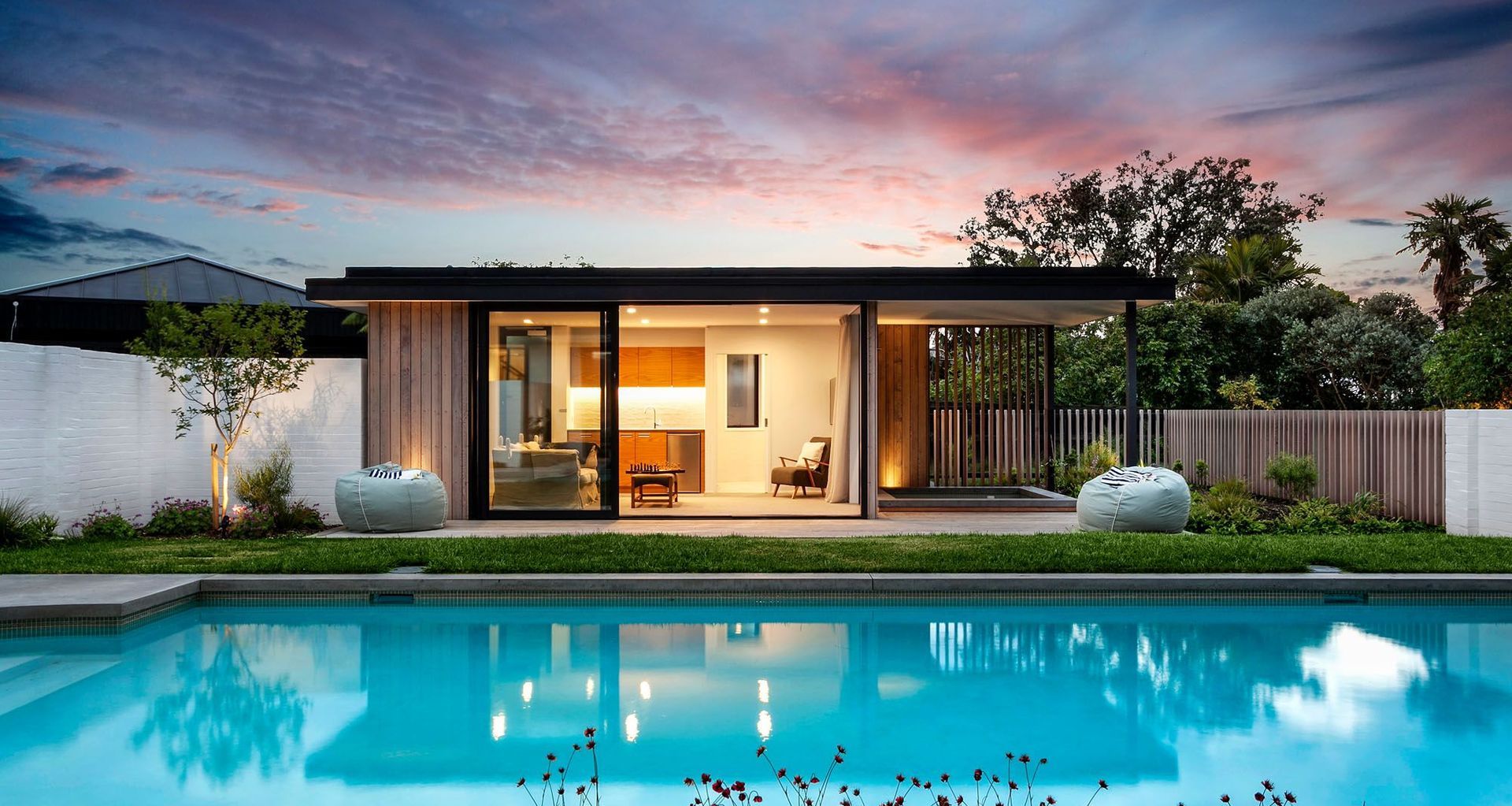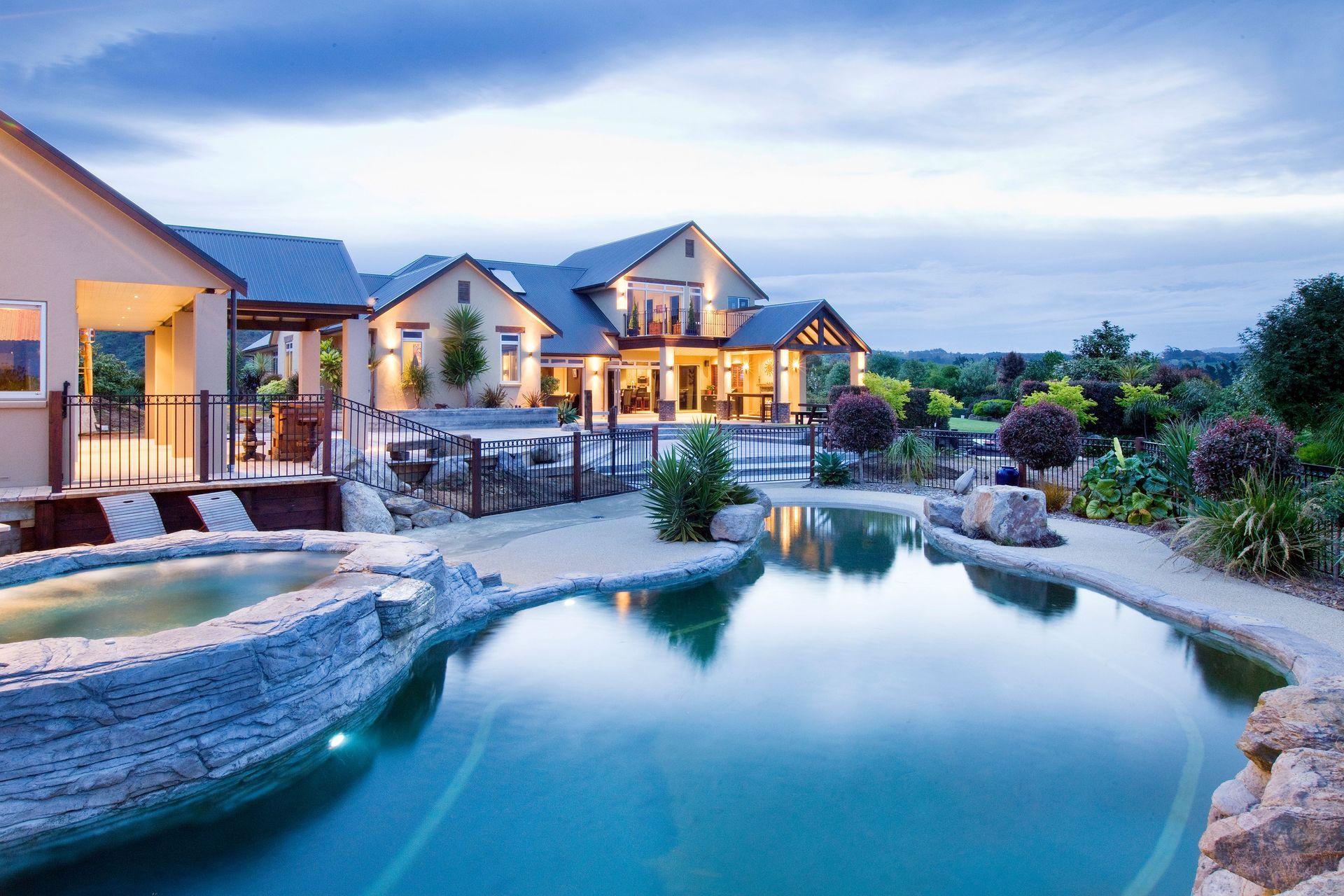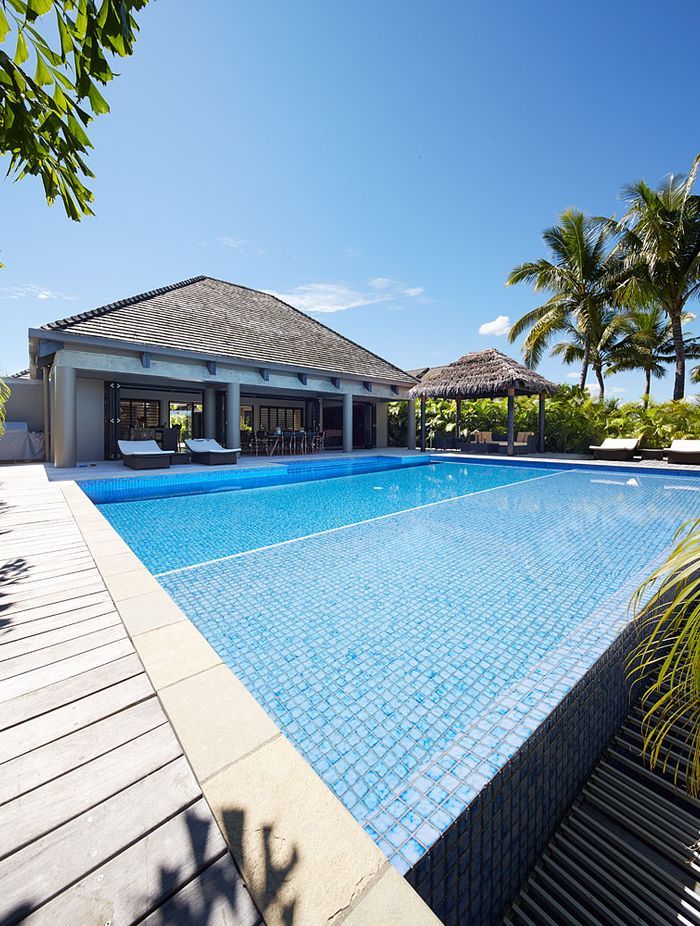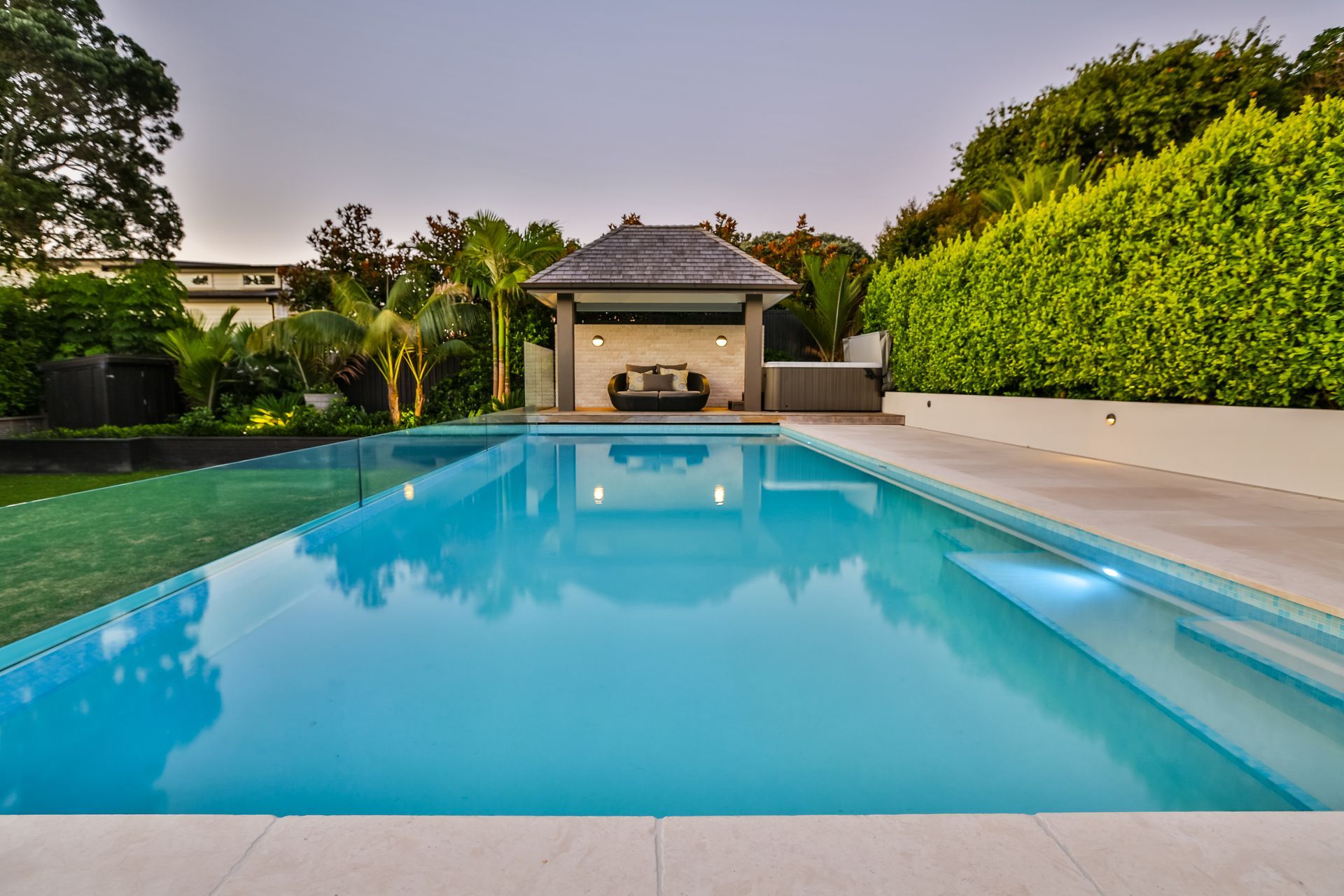Top pool design ideas: what to consider when building a swimming pool

The best place to start when deciding whether or not to incorporate a pool into the design of a new home, or to add one into an existing property, is the way it will be used. For example, will it be used for exercise such as swimming laps, or will its focus be as a recreational or relaxing addition to the home?
Once the pool’s proposed uses are identified, it’s easier to research different types of pools, understand what depth would be best suited, and whether or not it is worth the investment based on output vs. how much it will be used and the value it would add to the property. If it is, the following questions are worth considering as they can all impact on the final design and project cost.
Is the site suitable for building a pool?
In the same way steep or undulated terrain, difficult ground conditions such as rock, or unstable soil types such as peat or clay can escalate the costs of building a house, so too can this type of site propel the costs of building a pool. A level site is the ideal land for a swimming pool. If the property is in an earthquake-prone area or is prone to flooding, it may be a requirement to have a geotechnical engineer provide a report to determine the suitability of the site for a pool.
How much room is required to build a pool?
Pools can generally be built to any size or shape a site demands. However, there are often strict requirements, particularly in urban areas, about how close a pool can be located to a property’s boundary. It is worth checking the property’s title, as well as the relevant district plan to ensure you are aware of any relevant constraints.
What are the different types of pool?
There are many options when it comes to pools, ranging from above-ground to in-ground, as well as container pools, saltwater or chlorine pools, and natural and living pools.
What are the best types of inground pools?
The most common types of in-ground pools in New Zealand are fibreglass and concrete. Both have different benefits and drawbacks, and it will depend on what your final design aims are as well as project budget when deciding which is best for your project.
Fibreglass vs. concrete pools: what is more cost effective?
Concrete pools are generally more costly to build than fibreglass pools, especially if the design is complex.
Concrete pools are popular because they can be tailored to suit any size or shape as they are built on-site. They’re also structurally very strong and are visually stunning. Finishing options are vast and range from pebbles to a tiled finish, but they can be more expensive at the outset.
Compared to fibreglass, concrete pools are more of an undertaking in terms of the construction timeframe. A concrete pool is built on-site, which can mean it takes a number of months to complete.
Maintaining concrete pools can also be a more arduous task than maintaining fibreglass pools due to the more porous nature of concrete which means algae and bacteria grow within the pool more quickly.
What are the benefits of fibreglass pools?
Fibreglass pools are quick and relatively easy to install, and are generally the more cost-effective option as an initial investment than concrete pools. They are constructed off site and installation on site can take as little as one week depending on weather conditions.
They’re also easy to clean due to their smooth surface, something that also makes it more difficult for algae and bacteria to grow in the pool and reduces ongoing maintenance costs.
The smooth gelcoat surface of fibreglass pools is also a popular option for those with children as it is non-abrasive against the skin.
The potential drawbacks of opting for a fibreglass pool is a lack of design freedom. Generally, there is a set range of shapes and sizes to choose from, which are limited somewhat in dimension as they need to be transported to the site.
When are above-ground vinyl-lined pools the best option?
Prefabricated above-ground pools are another popular option, mainly due to the limited installation costs comparative to in-ground pools.
The vinyl lining is non-abrasive and smooth against the skin, and like fibreglass pools doesn’t foster algae growth and therefore requires less ongoing maintenance than concrete pools.
However, vinyl linings generally last anywhere from around five to nine years, after which time they need to be replaced to maintain the integrity of the pool.
Vinyl linings are generally very thin - around 30mm - so throwing objects or having pets in the pool can damage the surface.
In-ground vinyl-lined pools are another option, but the installation costs rise to around the same as the installation of a fibreglass pool. An in-ground vinyl-lined pool will require the same maintenance as an above-ground vinyl-lined pool.
Above-ground pools can reduce the costs associated with fencing if they are higher than the required fencing.
Are container pools cost effective?
Container pools are another emerging option for above-ground pools in New Zealand. Constructed from shipping containers, insulated and lined with moulded fibreglass, they are a cost-effective option, constructed off-site and delivered in one piece.
Fresh vs. saltwater pools: what’s better?
A common misconception about saltwater pools is that they don’t require chlorine. This isn’t the case: both fresh and saltwater pools are chlorinated to keep the water safe, clean and hygienic. The difference is that saltwater pools create their own chlorine, while chlorine needs to be added to a freshwater pool.
In traditional chlorinated pools, chlorine is added to the water in the form of a liquid or tablet, or it can be dispensed into the pool through an automated pump system.
Saltwater pools have similar pump and filtering systems to freshwater chlorinated pools, except they also incorporate a chlorine generator that essentially turns the salt into chlorine to keep the water clean and eliminates the need for chlorine to be manually added or pumped into the pool.

What are living and natural pools?
Like green walls and roofs, living and natural pools are a form of living architecture that regulate themselves organically, without the need for chemical intervention.
What is a living pool?
A living pool is a body of freshwater that naturally regulates and cleans itself with bio filtration systems, much like the way bodies of water and the ecosystems around and within them behave naturally.
A living pool requires no chlorine, treatments or chemicals, remaining clean and hygienic independently. It is an organic version of a swimming pool containing living water. Living pools are different from natural pools, which require a regeneration zone of live flora and fauna. A living pool incorporates an underground bio and phosphorous filter that purifies the water, keeping it clear and alive.
What is a natural pool?
Natural pools are also bodies of living freshwater, however, they are regulated in a more organic manner than living pools. The central design feature of a natural pool is the regeneration zone, which is planted with aquatic plants that oxygenate the water and filter it through their root systems.
Due to the aquatic plants in the regeneration zone, natural pools often appear as if they blend in with the surroundings, becoming more like a natural feature of the landscape than a traditional pool.
Along with plants, fish can be added to a natural pool, creating a different experience. Fish also help to keep insects at bay.
Both natural and living pools are designed to suit individual sites and can be different depths, shapes, and sizes. Often, an existing pond or pool can be converted into a natural or living pool.
Heated vs. non-heated pools: what are the options?
Whether or not to heat a residential pool is a personal choice, and will depend on budget, how often the pool be used throughout the seasons, and whether heating will increase enjoyment of the pool.
There are many options for pool heating, ranging from solar systems to complex contemporary offerings. Find out more about pool heating options.
Luxury relaxation: the benefits of hot tubs
Incorporating a hot tub into any landscape is guaranteed to create a drawcard for young and old. It’s hard to beat a soak in an outdoor hot tub at any time of year, and with so many options in terms of designer tubs now available, the choices are endless. Whether you’re looking for a tub that makes a design statement, or one that seamlessly blends in with the surrounds, the choices are vast. Peruse the latest in hot tub design.
Spas, like hot tubs, are a great design feature for any landscape, and with options ranging from portable spas to in-ground and custom-made spa pools, you’re not limited with choice. Perhaps it’s a tub with lounge or hydrotherapy seats, maybe its massage jets for ultimate relaxation, or perhaps it’s a spa designed to seat up to seven people, whatever the desired outcomes, a spa will change any outdoor area.
Often, making a feature out of a spa or hot tub, particularly if it is separate or not connected to a pool area can make a stunning statement in the garden.
Imagine relaxing in the hot tub or spa beneath the glow of well-placed LED lights, taking in the beauty of the landscaping around the garden. To take things a step further, a home sauna can create the perfect accompaniment to a spa or hot tub. Outdoor saunas are popular in New Zealand, with a large range of styles and models available.
Pool ideas for small spaces: lap and plunge pools and swim spas
Lap pools and plunge pools, as well as swim spas, can be great options for smaller sections where there is still the desire for a pool. Container pools can also be a good option for those areas where space is at a premium.
These types of pools can be incorporated into much smaller areas while still offering the experience of swimming. Where space is at a real premium, other elements may have to be sacrificed to make room for a pool. When this is the case, it can pay to engage a pool designer to ensure the best options are available and the design will work well in the long-term.
If there simply isn’t space for a swimming pool, but a body of water still appeals, rock pools or water features can be a stunning option and add the ambience of water without the requirement of size.
Pool ideas for larger spaces: infinity pools and custom-built designs
Where space and budget is not an issue, the options become endless. Whether it’s a cantilevered clifftop pool, a pool that flows from indoors to out, or an infinity pool complete with in-built spa, there is no limit to what can be achieved. Perhaps a section has an awkward angle, or an existing native that can’t be moved. Custom-built pools offer complete design freedom with the ability to create bespoke shapes, curves, and angles.
Read more and know the rule for building a safe pool: New Zealand swimming pool fencing and rules
Top banner image credit: Godden Cresent Renovations by Alignworks


